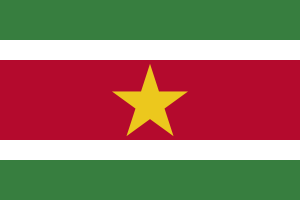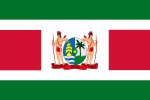Flag of Suriname
 | |
| Use | National flag and ensign |
|---|---|
| Proportion | 2:3 |
| Adopted | 25 November 1975 |
| Design | A horizontal triband of green (top and bottom) and red (double width) with large white border with the large yellow five-pointed star centered on the red band. |
The flag of Suriname is formed by five horizontal bands of green (top, double width), white, red (quadruple width), white, and green (double width). There is a large, yellow, five-pointed star centered in the red band.
The flag was adopted on November 25, 1975, upon the independence of Suriname. The star represents the unity of all ethnic groups, the red stripe stands for progress and love, the green for hope and fertility, and the white bands for peace and justice.
Flag before 1975
The pre-independence flag adopted in 1959 consisted of five colored stars connected by an ellipse. The colored stars represented the major ethnic groups that comprise the Surinamese population: the original Amerindians, the colonizing Europeans, the Africans brought in as slaves to work in plantations and the East Indians, Javanese and Chinese who came as indentured workers to replace the Africans who escaped slavery and settled in the hinterland. The ellipse represented the harmonious relationship amongst the groups.[1] There was also a flag for use by the Governor, based on the national flag.
 National Flag 1959-1975
National Flag 1959-1975.svg.png) Standard of the Governor
Standard of the Governor Standard of the Prime Minister, 1975-1988
Standard of the Prime Minister, 1975-1988 Presidential Standard
Presidential Standard Flag of National Army
Flag of National Army Prime Minister Henck Arron and opposition leader Jagernath Lachmon with the new flag in November 1975
Prime Minister Henck Arron and opposition leader Jagernath Lachmon with the new flag in November 1975